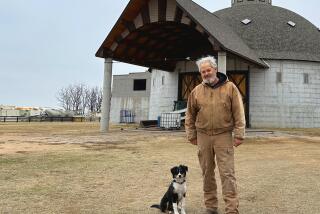‘See Rock City’ Barn Painter Recalls Career
CHATTANOOGA, Tenn. — Clark Byers was earning $3 a week bottling buttermilk when an adman from Chicago slapped a brush in his hand and helped him paint his way into Southern history.
It was during the Depression, and a promoter trying to draw crowds to the views and rock formations on his Lookout Mountain property wasn’t having much luck. The adman’s answer: Paint your logo on barn roofs to lure travelers off the highway.
Byers was hired and, over the next 30 years, painted “See Rock City” on 900 barns in 19 states from Michigan to Texas, Florida to North Carolina.
The barns, perhaps better known than the attraction itself, are slowly disappearing.
“It makes me realize how old I am,” said Byers, 83, of Rising Fawn, Ga.
The project began in 1936, when Rock City Gardens owner Garnet Carter and his advertising pal, Fred Maxwell, persuaded farmers to let their barns be painted. When Byers showed a talent for choosing locations, Carter mapped routes and sent him out on his own.
He loaded his paint, brushes, ropes and two helpers into a truck and scoped out the highways for days at a time. Barn owners were rewarded with a free paint job, Rock City bathmats and thermometers. Those who wanted more than trinkets were paid about $5.
The slogans--including “See 7 States From Rock City,” “Tell Your Friends About Rock City” and “To Miss Rock City Would Be a Pity”--were written in white paint on barns in Georgia, Alabama and Tennessee.
“I didn’t pass up a good roof,” Byers said. “I felt obligated to Garnet Carter to find the best roof I could.”
Byers and Carter were dubbed “barnyard Rembrandts,” and tourists flocked to Rock City. Byers painted up to six barns a day, repainting the logos every two years. He earned about $40 per barn, but had to use part of that money for paint and to pay his helpers.
“After we got acquainted with people, they were happy to see us come,” he said. “I’m still friends with many of them.”
The job also had its risks. Once, a bull got loose, trapping Byers atop a barn for hours. Sometimes homeowners chased him away, thinking he was a crook.
Once, the sharp edges of a barn roof sliced through a safety rope, hurtling Byers into a vegetable patch. His helper’s pants got caught on a nail at the roof’s edge.
“He was just hanging there,” Byers said. “It finally tore loose, and here he came tumbling down too.”
No one was hurt--that time. But Byers was seriously injured in 1968 when he was shocked by an electrical wire. He spent a year recovering and soon after retired.
About 200 of the original barns remain, and Rock City maintains about 73. No new barns have been painted since the federal Highway Beautification Act of 1965, which barred the ads along main roads.
Byers hopes to write a book on his experiences. Meantime, he and his wife continue working their farm in the northwest corner of Georgia.
“She thinks I’m a nut, and she’s right,” he said. “If I hadn’t been a nut, I wouldn’t have done what I did.”
More to Read
Sign up for The Wild
We’ll help you find the best places to hike, bike and run, as well as the perfect silent spots for meditation and yoga.
You may occasionally receive promotional content from the Los Angeles Times.




